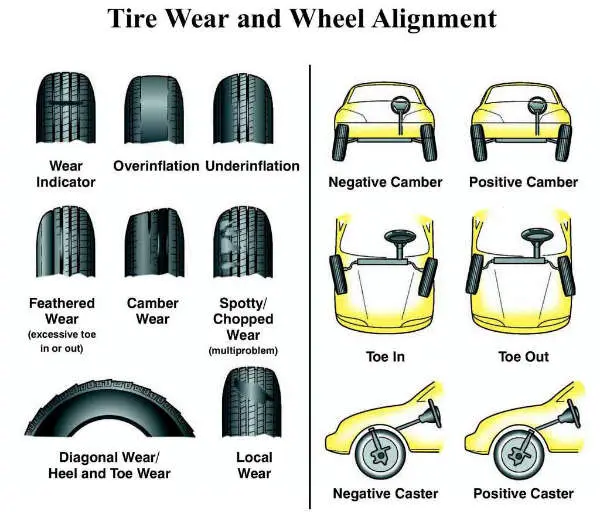
Wheel Alignment & Tires Basics: 🚗 Maintain Optimal Tire Life & Fuel Efficiency ⛽
Hello Car Owner! 👋
In the realm of automotive maintenance, wheel alignment and tire care stand as cornerstones of safety, performance, and cost-effectiveness. Maintaining properly aligned wheels and well-maintained tires not only enhances your driving experience but also safeguards your vehicle’s longevity and fuel efficiency. This comprehensive guide delves into the intricacies of wheel alignment and tire basics, empowering you with the knowledge to optimize tire life, maximize fuel efficiency, and ensure a smooth and safe ride.
Introduction 🚗
Your vehicle’s wheels are the pivotal points of contact between your car and the road, bearing the brunt of the forces generated during acceleration, braking, and cornering. Proper wheel alignment ensures that these forces are evenly distributed across the tire’s surface, maximizing tire life and optimizing fuel efficiency. Conversely, misaligned wheels can lead to uneven tire wear, reduced traction, increased rolling resistance, and diminished fuel economy.
Tires, the unsung heroes of your vehicle, play a multifaceted role in ensuring a safe and enjoyable driving experience. They provide traction, absorb road irregularities, and maintain stability while cornering. Properly inflated and maintained tires not only enhance your car’s handling and performance but also contribute to fuel efficiency and extend tire lifespan.
The Importance of Wheel Alignment 🚗
Wheel alignment, often overlooked yet critically important, plays a pivotal role in your vehicle’s overall performance and safety. It ensures that all four wheels are positioned correctly relative to each other and to the road surface. Proper wheel alignment yields a myriad of benefits, including:
- Enhanced Tire Life: Evenly distributed forces across the tire’s surface minimize uneven wear, extending tire life.
- Improved Fuel Efficiency: Properly aligned wheels reduce rolling resistance, resulting in improved fuel economy.
- Reduced Steering Effort: Correctly aligned wheels make steering easier and more responsive, enhancing driving comfort.
- Enhanced Handling and Stability: Optimal wheel alignment ensures precise handling and stability, particularly during cornering and evasive maneuvers.
- Safer Driving: Properly aligned wheels contribute to overall vehicle safety by maintaining optimal traction and control.
The Effects of Misaligned Wheels ⚠
Misaligned wheels, a common ailment among vehicles, can wreak havoc on your car’s performance, safety, and wallet. Common consequences of misaligned wheels include:
- Uneven Tire Wear: Misalignment causes uneven distribution of forces across the tire’s surface, leading to premature and uneven wear.
- Reduced Fuel Efficiency: Misaligned wheels increase rolling resistance, resulting in diminished fuel economy.
- Increased Steering Effort: Improper wheel alignment makes steering more difficult and less responsive, compromising driving comfort.
- Impaired Handling and Stability: Misaligned wheels adversely affect handling and stability, especially during cornering and evasive maneuvers.
- Compromised Safety: Misaligned wheels can diminish traction and control, posing safety risks.
The Importance of Tire Maintenance 🚗
Tires, the workhorses of your vehicle, require regular maintenance to ensure optimal performance and longevity. Proper tire care practices encompass:
- Tire Pressure Monitoring: Regularly checking and adjusting tire pressure to manufacturer specifications is crucial for maintaining proper tire shape, maximizing tread life, and enhancing fuel efficiency.
- Tire Rotation: Periodically rotating tires ensures even wear, extends tire life, and improves overall vehicle performance.
- Tire Inspection: Regularly inspecting tires for signs of damage, such as cuts, bulges, or excessive wear, is essential for identifying and addressing potential issues promptly.
- Tire Alignment: Maintaining proper tire alignment is vital for optimizing tire life, fuel efficiency, handling, and safety.
- Tire Selection: Choosing the right tires for your vehicle and driving conditions is crucial for maximizing performance and safety.
The Effects of Poor Tire Maintenance ⚠
Neglecting tire maintenance can have detrimental consequences for your vehicle’s performance, safety, and longevity. Common outcomes of poor tire maintenance include:
- Premature Tire Wear: Inadequate tire pressure, improper alignment, and lack of rotation can lead to uneven and premature tire wear.
- Reduced Fuel Efficiency: Underinflated tires increase rolling resistance, resulting in diminished fuel economy.
- Compromised Handling and Stability: Poor tire maintenance adversely affects handling and stability, especially during cornering and evasive maneuvers.
- Increased Risk of Accidents: Worn or damaged tires can compromise traction and control, increasing the risk of accidents.
- Shorter Tire Lifespan: Lack of proper maintenance can significantly reduce tire lifespan, resulting in more frequent and costly tire replacements.
Wheel Alignment & Tires Basics: A Guide to Optimal Performance 🚗
To ensure optimal performance and longevity of your vehicle’s tires, it is crucial to maintain proper wheel alignment and adhere to recommended tire maintenance practices. Here’s a comprehensive guide to help you achieve this:
- Regular Wheel Alignment Checks: Have your vehicle’s wheel alignment checked
List of Content : show